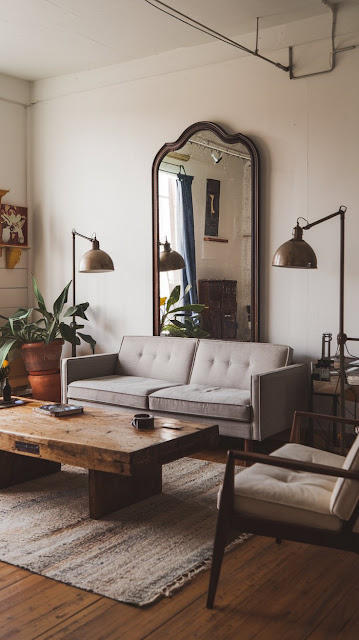Eco-Friendly Home Decor Ideas for a Sustainable Living Space
In today’s world, sustainable living is more important than ever, and our homes are a great place to start. By incorporating eco-friendly decor into your living space, you can reduce your environmental footprint while also creating a beautiful, calming, and thoughtful home environment. Sustainable home decor doesn’t just benefit the planet—it also helps promote a healthier, toxin-free living space for you and your family.
In this article, we’ll explore a variety of eco-friendly home decor ideas, each designed to enhance the aesthetic of your space while supporting environmental responsibility. From upcycling furniture to choosing organic materials, here are some ways to create a sustainable, stylish home.
1. Upcycled and Recycled Furniture
One of the most impactful ways to embrace eco-friendly decor is by upcycling or purchasing recycled furniture. Instead of buying new pieces, consider repurposing old furniture by giving it a fresh coat of paint, adding new hardware, or turning it into something entirely different. Upcycled furniture not only reduces waste but also adds a unique, personalized touch to your home.
How to Implement:
- Visit thrift stores, flea markets, or online marketplaces to find second-hand furniture.
- Get creative with DIY projects by repainting or refinishing old pieces.
- Use reclaimed wood for custom-made furniture, such as tables, shelving, or bed frames.
2. Natural and Organic Materials
When choosing home decor, opt for natural and organic materials like bamboo, cork, linen, and organic cotton. These materials are not only biodegradable but also more sustainable to produce. For example, bamboo is fast-growing and regenerates quickly, making it an excellent eco-friendly option for furniture, flooring, or decor accents.
How to Implement:
- Use bamboo or cork for flooring, furniture, or even decorative items like trays and picture frames.
- Opt for organic cotton or linen for bed linens, curtains, and cushions.
- Choose sustainably sourced wood or wool for furniture and textiles.
3. Energy-Efficient Lighting
Energy-efficient lighting is an important component of eco-friendly decor. LED bulbs, for instance, use significantly less energy than traditional incandescent bulbs and last much longer, reducing the frequency of replacements. Additionally, incorporating natural light through strategically placed windows, mirrors, or skylights can minimize the need for artificial lighting during the day.
How to Implement:
- Replace all incandescent bulbs with LED or CFL bulbs to reduce energy consumption.
- Install dimmer switches to control lighting levels and save electricity.
- Place mirrors near windows to reflect natural light and brighten up the room.
4. Eco-Friendly Paint and Finishes
When painting your walls or refinishing furniture, choose non-toxic, low-VOC (volatile organic compounds) paints and finishes. VOCs are harmful chemicals that can off-gas into your home’s air, affecting indoor air quality and health. Eco-friendly paints are made with fewer chemicals and natural pigments, making them a safer, sustainable option.
How to Implement:
- Select low-VOC or zero-VOC paint for your walls in neutral or earthy tones.
- Use water-based, eco-friendly varnishes or finishes for wooden furniture and floors.
- Opt for natural dyes or stains for wooden decor elements.
5. Indoor Plants for Natural Air Purification
Adding indoor plants to your home not only enhances its aesthetic but also improves indoor air quality by naturally filtering out toxins. Plants like spider plants, snake plants, and peace lilies are known for their air-purifying abilities. Incorporating greenery into your decor brings a sense of calm and connection to nature, all while promoting sustainability.
How to Implement:
- Place potted indoor plants in various rooms to add greenery and purify the air.
- Use eco-friendly pots made from natural or recycled materials.
- Create a small indoor herb garden to grow your own herbs for cooking.
6. Sustainable Rugs and Textiles
When choosing rugs, throws, and other textiles for your home, look for sustainable options made from natural fibers like jute, wool, or organic cotton. These materials are biodegradable, renewable, and often produced using environmentally friendly methods. Handwoven or fair-trade textiles also support ethical practices and artisans in developing countries.
How to Implement:
- Use jute or wool rugs for living rooms, bedrooms, or hallways.
- Choose organic cotton throws and blankets to add warmth and comfort.
- Look for fair-trade textiles to ensure ethical production and support for artisans.
7. Vintage and Antique Decor
Decorating with vintage or antique pieces is another excellent way to reduce waste and promote sustainability. Whether it’s an antique mirror, a vintage lamp, or a reclaimed wooden table, these items give your home a unique character while reducing the demand for new products and minimizing resource consumption.
How to Implement:
- Incorporate vintage lamps, mirrors, or vases into your decor.
- Use antique furniture or reclaimed wood for a rustic, timeless look.
- Repurpose old decor items to create something new and functional.
Conclusion
Creating an eco-friendly living space doesn’t mean sacrificing style. With mindful choices and sustainable materials, you can design a beautiful, environmentally responsible home that reflects both your taste and your values. By incorporating upcycled furniture, natural materials, energy-efficient lighting, and air-purifying plants, you’ll be contributing to a healthier planet while enjoying a serene, toxin-free living environment.
By focusing on sustainability, we can make our homes more than just places to live—we can create spaces that positively impact the environment and promote healthier, greener living for ourselves and future generations.









Comments
Post a Comment